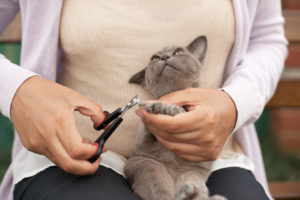
What to Expect When You Adopt a Kitten
You love kittens – you follow The Kitten Lady on Facebook, you watch all the Jackson Galaxy videos you can find on YouTube, and you’re finally ready to adopt a kitten of your very own! But what can you expect over the first few weeks, months, and years with your new furry best friend? Read below to find out more.
Article Quicklinks:
- Stocking your home with kitten supplies
- Introducing your kitten to your home
- Kitten medical care in the first year
- Kitten manners and behavior
Bringing Home Baby (Kitten)

Congrats! You’re ready to adopt a kitten from A.R.F.! Your bundle of furry joy will be at least 8 weeks old, have age-appropriate vaccinations, and will be spayed or neutered (except if delayed for medical reasons). Your adoption paperwork from A.R.F. will have a coupon for a free healthy pet vet visit at participating veterinarians within 7 days of adoption – be sure to take advantage of it to make sure everybody is healthy.
You’ll want to have the following supplies ready for your new baby:
- Dry and wet kitten food – ask the foster volunteer for what kind of food they like and try to get that brand. You can slowly substitute to your preferred brand over time.
- Food and water bowls – shallow depth so kittens can get their tiny heads over the edge.
- Litter box – for small kittens, make sure it has a low edge so they can climb in. Sterilite bins make great cheap litter boxes.
- Cat litter – ask the foster volunteer what kind of litter the kitten is using.
- Toys – an assortment of soft balls, string toys (don’t use unsupervised), catnip mice, hair ties, milk jug rings, etc. You’ll never know what a kitten will want to play with!
- A bed or two – try one that converts between covered and uncovered to cater to your new kitten’s preferences.
Keep Their World Small At First
When introducing your adopted kitten to your house, keep them in a confined area for a few days until they are used to the smells and sounds of your home. An unused bathroom is ideal for this, but a bedroom or den also works. Make sure the kitten has a secure place to hide and observe until they are confident to venture out and explore.
Once they are more comfortable, let them out of the room little by little. They will be curious and want to explore further, but let them move at their own pace. Don’t pick them up right away, let them come over to you on their own. It might take your new kitten a week or two to adjust to their new home. You have an entire life of snuggles ahead of you, a little patience here will pay off in the long term.
Your new kitten might not eat much at first, but should continue to drink and use the litter box. If you have concerns after a few days, consult your veterinarian.
Medical Care for Your New Kitten

Kittens will require medical care in the first few months after adoption to set them up for a healthy life. The following care needs to be provided in the first year depending on the age of your adopted kitten:
- FVRCP vaccine – this vaccine is a series of shots until the kitten is 16-20 weeks old. This vaccine prevents three potentially deadly viruses in kittens: Rhinotracheitis, Calicivirus, and Panleukopenia.
- Rabies vaccine – cats and kittens over 16 weeks old are required to be vaccinated per IL state law.
- Fecal exam – while A.R.F. proactively treats our foster cats and kittens for parasites, sometimes they can hang out in places medicine can’t reach. We recommend a fecal exam in the first year to double check.
- Flea treatment – your veterinarian might recommend regular topical flea treatments if your cat is exposed to other pets that go outside, just in case. Fleas (and subsequent tapeworms) are no fun to deal with.
- Annual exam – we recommend planning for regular well-pet exams according to the schedule your veterinarian suggests. Kittens might require multiple exams in the first year.
Minding Your (Kitten) Manners
Kittens, like human babies, are mostly blank slates. Some things they will already know – it is (mostly) instinctual that cats will use a litter box, play by hunting toys, and enjoy a good snuggle. But some behaviors need to be trained to turn a kitten into a well-mannered adult cat, such as the following items.
Discourage playing with fingers and ankles
Kittens love to attack anything that moves, and wiggly fingers and moving ankles look like the perfect plaything (especially for single kittens, more on that below). Kittens are mini predators and have an instinct to bite things, so it is important to train them to bite the correct thing, i.e. not people.
If a kitten attacks your hands, immediately take them away and redirect to another toy. Encourage playing with toys to get their energy out before they have a chance to move to humans as prey. It might be extremely adorable for your 3-pound kitten to play with your fingers, but its not so cute when he is 15 pounds and still attacking you.
Climbing In Appropriate Places
The first time a kitten climbs your legs while waiting for dinner is cute, but its not cute when they start to climb the curtains, screen doors, the back of couches, and more. Give your new kitten a place that they can call their own, up high, with an easy way to climb up.
Cat trees or other furniture give “tree dwellers” a way to observe everything from up high. When kittens start climbing in inappropriate places, gently redirect them to their own safe kitty penthouse.
Embracing Nail Trims

Declawing for behavior reasons is never ok. Full stop. Start early to get your kitten used to having their paws handled, which will make nail trims easier when they are older. When your kitten is sleepy or relaxed, gently play with their paws. Touch them, rub them, gently extend the claws, etc. If they start to pull away, wait until they are more relaxed to continue playing with the toe beans. Continue to do this throughout your cat’s life. Trimming nails is significantly easier when a cat is used to having their paws handled.
Scratching the Right Stuff
Again, declawing to prevent scratching furniture is not ok. If your kitten is trying to scratch furniture (we’ve found nubby fabric chair arms to be favorites), gently redirect them to a scratching post.
Cats can prefer different types of posts such as upright, twine-wrapped, carpet- or sisal-covered, cardboard, horizontal, hilarious, or any combo of the above, etc. If they don’t seem interested in the post you have, try another type until you find one they love. Use aluminum foil or double-sided tape to keep kittens from scratching furniture until you find the right post.
Single Kitten Syndrome

A.R.F. gives preference to applicants that want to adopt kittens in pairs. Why? Because it prevents so-called Single Kitten Syndrome, which is a leading reason why cats and kittens get surrendered to shelters and rescues.
Single Kitten Syndrome is when an only-kitten gets lonely and bored and lets his energy out in inappropriate ways – biting fingers, scratching faces, attacking ankles, climbing the drapes, and so on. Essentially all the behaviors you DON’T want your kitten to have. If the behavior isn’t corrected when the kitten is young, it can lead to aggression as adults.
When you adopt two (or more!) kittens, they have a friend to work out all that excessive energy. Another kitten or adopting a cat will teach the kitten “how to cat” including that scratching faces isn’t ok, playing with a friend is better than biting ankles, and biting hurts and we shouldn’t do it.
Spring Kittens vs. Fall Cats
A lot of adopters think that a kitten will help their senior cats be more playful and lead a more active life. However, an older/senior cat might not want a new kitten friend. Can you imagine being middle-aged and all of a sudden there is a new toddler in your house that you’re expected to take care of? Humans wouldn’t like that, and neither do cats. Getting constantly pounced when all you want to do is nap in the sun isn’t a good thing for anybody, human or cat.
Cats that are younger or more active would appreciate having a playmate to keep their time occupied, and they can act as a “finishing school” for young wayward kittens. Read more about how to introduce a new cat to your existing cat to make sure the introduction goes smoothly.
Pulling it All Together
Congrats! You’re ready to bring home your kitten for many years of happy snuggly fun! Be patient in all things as your new kitten gets used to their new home. All of this is a novel experience for them, and they need time to adjust to these new things. If you have any questions or concerns (or want to share cute kitten pictures!) reach out to your A.R.F. volunteer foster or contact us.
